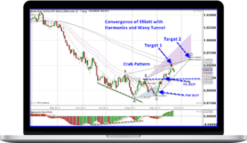Scott Brown – Bullet-Proof Options – Controlled Leverage Investing Methods
$84.99 $9.00
Total Sold: 1
»Instant Delivery
Description
Scott Brown – Bullet-Proof Options – Controlled Leverage Investing Methods
If you look at my research you can see why the Wolves of Wall Street would like to silence me. My work shows that every penny spent on investment newsletter advice is money flushed down the toilet.
That is because those who can make money in the market won’t bother with the technical problems of running an investment newsletter. Newsletter editors who make enough writing an investment newsletter do so because they can’t make money in the market.
And that is just what the newsletters are trying to get you to do what they say when they write “buy this” or “sell that.” Here is an actual line that just hit my mailbox,
“The true story of how this trader turned $2,000 into $10 million from his kitchen table, in 9 months.” Don’t for a moment believe this lie.
If these marketers can get you to take action in your trading account they know one thing for certain.
It will be a snap to get you to buy their next dud of an expensive annual fee investment newsletter, $5,000 course or $20,000 boot camp — glossed up with fancy promises and fancy sales copy writing. These marketers make their money selling shiny ideas without regard to the true returns underlying each strategy.
The underlying economics of the newsletter industry I reveal to you is quite bizarre.
Investment newsletter subscribers lose millions every year investing in bad ideas. Investment newsletter publishers make millions in annual subscription fees.
But now I have uncovered the ultimate lie from the Wolves of Wall Street. This investment fib truly pukes up losses of scandalous proportions.
Which Option Strategies Are Tailor Made For Those Born to Lose?
If you have ever been interested in options there are a few strategies you must immediately become aware of to avoid like the plague. These fundamental options trading techniques are guaranteed to lose straight out of the barrel.
And they form the basis for compound option trading strategies that expose investors to very big losses. Why are these strategies so popular among brokers as well as newsletter editors?
Compound option strategies don’t just cause complex losses they also kick out vastly larger brokerage fees.
But the true returns to investors of these strategies have been so hard to calculate that it was impossible to “prove” the danger to investor accounts. So it was easy for investment newsletter marketers to falsely claim that these horrific options trading strategies actually made money.
Until now!
A seminal option trading article came out last year in the #1 ranked Journal of Finance. This probing study proves that most strategies touted by the financial media are a sure ticket to the poor house. And the Wolves of Wall Street are biting their nails in hopes that you never learn the truth that emerges from this article.
Watch Advanced Training 2 — Stock Options as Lotteries
The research is so full of “rocket science” math that the true meaning has never been revealed to the public — until now by me to you. This cutting edge research proves beyond a shadow of a doubt that only one of these options strategies is a winner.
- Buying index and ETF options.
- Selling Index and ETF options.
- Covered Calls
- Put Selling
- Short Expiration Call
- Short Expiration Put
- Protective Put
- Bull Spread
- Bear Spread
- Iron Condor Spread
- Butterfly Spread
- Deep in the Money Far Expiration Call
- Straddle
- Strangle
isn’t that crazy?
Only one of the strategies above is a winner?! Can you guess which?
Most option strategies c are outright disastrous or produce mediocre returns to the investors who try them.
One strategy alone on the list above actually stands to make investors big money. Do you want to know which?
It truly is the one perfect option strategy. Enroll now and here is what you get…
Bullet-Proof Options – Controlled Leverage Investing Methods teaches you how to trade the one — perfect — option strategy. I take you by the hand and mentor you through each step of my unique ultra-high beta controlled leverage long term investment process.
Introduction 1 — The Option Mechanics Toolbox Every Savvy Stock Investor Must Master
Benefits to you …
- Laser impress permanently into your mind the precise mechanics of exercise and strike.
- See why index options can be very different beasts from plain vanilla stock options.
- Marvel at the modern American invention of the derivative.
- How options derive their value from underlying investments.
- Watch as I reveal to you how the option price is derived from the underlying.
- Grasp the power of extrinsic time value above and beyond intrinsic option premium price.
- Develop a strong sense of moneyness.
- Utilize payoff diagrams for serious real money campaigns.
- See how a covered call is the same as a bank deposit, a call and a short stock.
- Employ a time decay chart to clearly see your best option bets for maximal probable profits.
Introduction 2 — Basic Option Pricing with Binomial Outcome Trees for Valuation!
More benefits to you …
- Model option value on expiration date.
- Calculate the hedge ratio also known as delta.
- See how option premium changes for each unit rise of underlying stock.
- Grasp how options trade in a parallel yet connected universe with equity markets.
- See risk neutrality as a special case of certainty equivalence.
- Marvel at how call option payoff is zero in the binomial down state.
- Reintroduce yourself to Euler’s number from high school math.
- Create a pyramidal matrix of possible share prices.
- Use the risk free rate of return to model forward up and down share price movements.
- Plug probabilities of a rise or fall into the binomial model.
Introduction 3 — Black Scholes Option Pricing Theory and the Real World Impacts!
Even more benefits …
- Recognize the five key variables Fischer Black and Myron Scholes used to model option pricing.
- Utilize the knowledge of how fluctuations of the underlying stock influence the price of puts and calls.
- Know when underlying volatility is pumping up option values.
- Wonder at how increasing interest rates actually increases call values but hammer put prices.
- Employ the VXN to compare the implied volatility of the NASDAQ to that of any other stock market index.
- Grasp the value of a call as the share price less a bank loan.
- Blaze into your mind via a time decay chart the reality that the farther out in expiration an option is the more valuable it becomes.
- Derive year fractional expiration as days remaining divided by 365.
- Value any call as delta times the underlying share price less a bank loan.
- Repulse at how warrants gifted to fat cats dilute your ownership share in private placement investments.
Introduction 4 — Real Options Offer Insights Into Your Real Estate Investments!
Yet still more benefits …
- Analyze the choice of two real estate option projects under high and low demand.
- Consider the real option case of oil tankers that can be mothballed when unprofitable.
- Reflect on the combination-turbine electricity market from a real options perspective.
- Ponder how large aircraft assembly firms streamline sales with real options.
- Peruse a graph that proves that the NPV of a real option decision to purchase an expensive asset is about zero with long time to delivery.
- Why real options are rarely available in practice.
- See how real options apply to pharmaceutical share pricing as firms move through consecutive FDA approval trails.
- Examine how real options can change underlying pricing conditions.
- Build your understanding of how real estate options can help you.
- Strengthen your economic intuition with knowledge of real options.
What You’ll Learn In Bullet-Proof Options – Controlled Leverage Investing Methods?
- Discover the vast yet small differences between American puts and calls and their European style kissing cousins.
- Map the span of puts and calls across stocks, futures and forex.
- Fathom how new financial assets are created from other assets.
- Master the concept of option premium so similar to insurance payments.
- Measure the intrinsic value between the strike and underlying price.
- Clarify complex jargon such as the exercise and strike which have the same meaning.
- Learn to use position diagrams for deep economic intuition into option trading strategy.
- Fully visualize the break-even point of any option transaction.
- Use these keen insights to develop the put-call parity relationship.
- Map out the valuation limits on both puts and calls.
- Use the binomial model to solve any option valuation problem.
- Correctly gauge how up and down underlying movements influence option valuation.
- Use option delta as the ratio of the spread of possible premium values over share price possibilities.
- Arrange valuation modeling within a risk-neutral universe.
- Link the sigma volatility of underlying stock to option premium price.
- Employ the binomial option pricing model of finance professors Cox, Ross, and Rubenstein.
- Watch the binomial model converge to the Black-Scholes.
- Calculate values and probabilities at each node of a binomial model.
- Estimate the direct measure of rise in a stock.
- Recall Euler’s number as equal to 2.71828.
- Harness the ultra-precise power of continuous time mathematics to calculate the true value of your options.
- Pull delta values from cumulative normal distribution tables of the Excel function NORMSDIST(d).
- See how increasing the exercise price ramps up put value but hammers calls.
- Map out each of the components and variable of the Black-Scholes pricing model.
- See how far times to expiration are more costly but offer far more protection against adverse underlying share price movements.
- Become wise as to the meaning of the log-normal distribution rightward skew and limited downside.
- Learn to expect more extreme profitable movements than you would otherwise expect.
- Calculate call values for employee stock options gifted to dirt bag CEOs and their crony crew.
- Utilize the VIX to measure aggregate fluctuations in market wide implied volatility.
- Recognize that there are at least five other option pricing variations in addition to the binomial and the Black-Scholes models for unique market situations.
- Recognize your real option to wait.
- Understand real options to expand.
- View trimming down or abandoning as a real option for corporate managers.
- See the ability to adjust or vary production and output as a valuable real option.
- Recognize the value of a real option as the difference between project NPV with and without the option.
- Use real options to re-value negative NPV projects with vast turnaround potential.
- Graph out the real option to wait.
- Diagram the loss in option value if a competitor beats firm managers to the punch.
- See how the ability to wait and do nothing offer higher real option values.
- Memorize the relationship that Real Option Value = Intrinsic Value + Time Premium
More courses from the same author: Scott Brown
Delivery Policy
When will I receive my course?
You will receive a link to download your course immediately or within 1 to 21 days. It depends on the product you buy, so please read the short description of the product carefully before making a purchase.
How is my course delivered?
We share courses through Google Drive, so once your order is complete, you'll receive an invitation to view the course in your email.
To avoid any delay in delivery, please provide a Google mail and enter your email address correctly in the Checkout Page.
In case you submit a wrong email address, please contact us to resend the course to the correct email.
How do I check status of my order?
Please log in to TradingAZ account then go to Order Page. You will find all your orders includes number, date, status and total price.
If the status is Processing: Your course is being uploaded. Please be patient and wait for us to complete your order. If your order has multiple courses and one of them has not been updated with the download link, the status of the order is also Processing.
If the status is Completed: Your course is ready for immediate download. Click "VIEW" to view details and download the course.
Where can I find my course?
Once your order is complete, a link to download the course will automatically be sent to your email.
You can also get the download link by logging into your TradingAZ account then going to Downloads Page.
Related products
Total sold: 11








